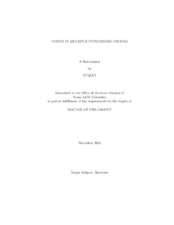| dc.description.abstract | It is common to test many hypotheses simultaneously in the application of statistics.
The probability of making a false discovery grows with the number of statistical tests
performed. When all the null hypotheses are true, and the test statistics are indepen-
dent and continuous, the error rates from the family wise error rate (FWER)- and
the false discovery rate (FDR)-controlling procedures are equal to the nominal level.
When some of the null hypotheses are not true, both procedures are conservative. In
the first part of this study, we review the background of the problem and propose
methods to estimate the number of true null hypotheses. The estimates can be used
in FWER- and FDR-controlling procedures with a consequent increase in power. We
conduct simulation studies and apply the estimation methods to data sets with bio-
logical or clinical significance.
In the second part of the study, we propose a mixture model approach for the
analysis of ChIP-chip high density oligonucleotide array data to study the interac-
tions between proteins and DNA. If we could identify the specific locations where
proteins interact with DNA, we could increase our understanding of many important
cellular events. Most experiments to date are performed in culture on cell lines, bac-
teria, or yeast, and future experiments will include those in developing tissues, organs,
or cancer biopsies, and they are critical in understanding the function of genes and proteins. Here we investigate the ChIP-chip data structure and use a beta-mixture
model to help identify the binding sites. To determine the appropriate number of
components in the mixture model, we suggest the Anderson-Darling testing. Our
study indicates that it is a reasonable means of choosing the number of components
in a beta-mixture model. The mixture model procedure has broad applications in
biology and is illustrated with several data sets from bioinformatics experiments. | en |


